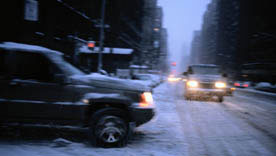You can go in snow
By: Jack Nerad for Driving Today
Date: 2005-01-21
Has it ever snowed at the Indianapolis 500? Has the Daytona 500 ever been postponed by a sudden ice storm? Has a blizzard ever wiped out the Monaco Grand Prix?
Since the answer to all these questions is no, you might wonder what a race driver (or in this case, a race driver school) can tell you about winter driving. And the answer is: a whole bunch. Why? Because race driving is all about car control--keeping the car balanced as close to the limit of its capabilities as is humanly possible, and that's similar to what safe winter driving is all about.
Snow, ice, and wet conditions substantially lower a vehicle's traction and handling capabilities. For instance, a turn that you could negotiate with ease at 60 miles per hour in dry weather might suddenly become nearly impossible to negotiate at 30 miles per hour if it is covered with water, so understanding you car's limits and keeping your demands on the car within those limits is the key to safe winter driving.
With this important fact in mind, the Jim Russell Racing Drivers School, based in Sonoma, California, offers the following helpful instructions as part of its safe driving course curriculum.
Winter driving tips
1. Don't try to stretch more miles from your tires during the winter months. If your tread depth is getting low, it can have serious effects on dry pavement, but those effects are multiplied in wet and snowy conditions. When in doubt, get new tires.
 2. Keep tires inflated to the designated pressure (pounds per square inch or "PSI" number) listed in your car owner's manual or on the door jamb. Under-inflated tires can cause a car to react more slowly to steering, and they can also overheat, which could lead to a blowout. [Don't use the PSI rating on the tire--that is the maximum, not the amount recommended for that particular car. See "Myths abound on correct tire inflation."]
2. Keep tires inflated to the designated pressure (pounds per square inch or "PSI" number) listed in your car owner's manual or on the door jamb. Under-inflated tires can cause a car to react more slowly to steering, and they can also overheat, which could lead to a blowout. [Don't use the PSI rating on the tire--that is the maximum, not the amount recommended for that particular car. See "Myths abound on correct tire inflation."]
3. Winter snow tires are superior to "all-season" tires in snowy conditions. While the trend of the last two decades has been away from a yearly change to snow tires in the fall and back to "summer" tires in the spring, the fact is that tires designed specifically for winter use provide superior handling and traction in winter conditions. Depending upon where you live, you might want to consider purchasing a set of winter tires for the inclement-weather months.
4. Test your car's handling and brakes in snowy conditions with no other cars nearby so you'll know how the vehicle will react in braking situations. Practicing in an empty, snow-covered parking lot could save you an accident or even your life when you are back on the open road.
5. Of course, your goal is to avoid skids and spins. Knowing your vehicle's limits in unfavorable conditions goes a long way to assure that but if you suddenly go past the knife-edge of control, there are some techniques to help you avoid disaster.
6. Focus on where you want to go and your hands will follow on the wheel, guiding you in the correct direction. While this sounds like an auto version of Zen, it works. Conversely, looking where the car is skidding can cause you to steer in that direction, causing a spin-out.
7. In a skid, keep your foot off the brake and the accelerator and concentrate on steering until you regain control. Sudden inputs of braking or acceleration can just make things worse.
8. Once you've recovered from the skid, gently apply the brakes. Skids turn into spin-outs when the driver applies the brakes too hard.
9. If you're in a full spin-out, apply the brakes hard and hold them to slow down the car. Pumping the brakes will cause the car to "float" in multiple directions during the spin.
10. If you're behind someone skidding, continue driving straight forward and slow down safely. Don't attempt to pass a skidding car.
Unfortunately, the leading cause of death during winter months is transportation accidents, according to the Federal Emergency Management Agency. If you apply these tips for safe winter weather driving, you can avoid becoming one of those nasty statistics.
---A native of Chicago, Driving Today Managing Editor Jack R. Nerad has had more than his fill of winter driving.
- Drivers.com article: Be prepared for winter driving (car kit)
- Drivers.com article: Myths abound on correct tire inflation
- Drivers.com article: More rain, snow makes driving safer?
Comments to this article have been disabled.
